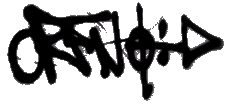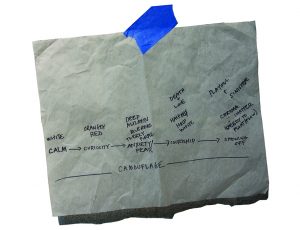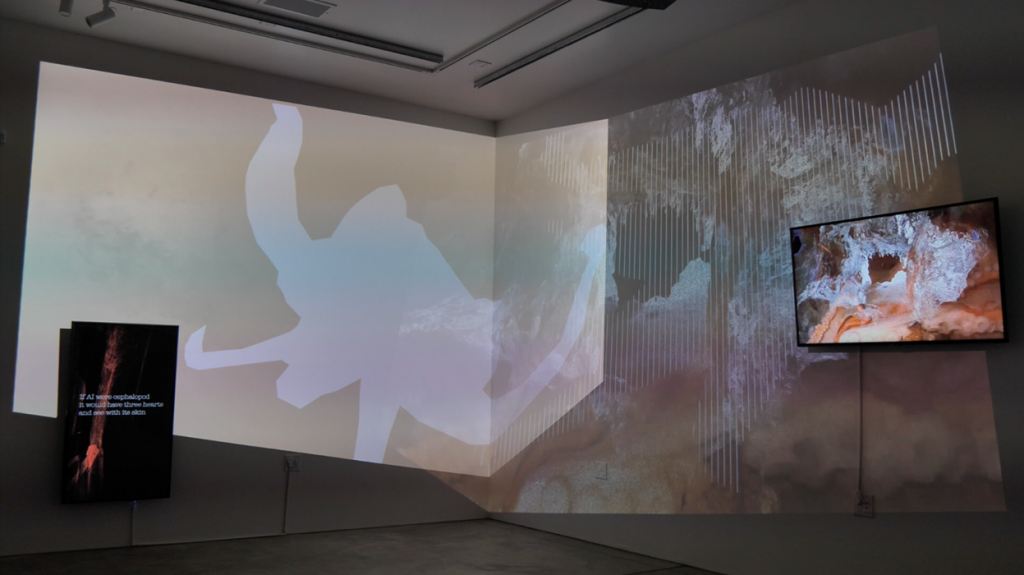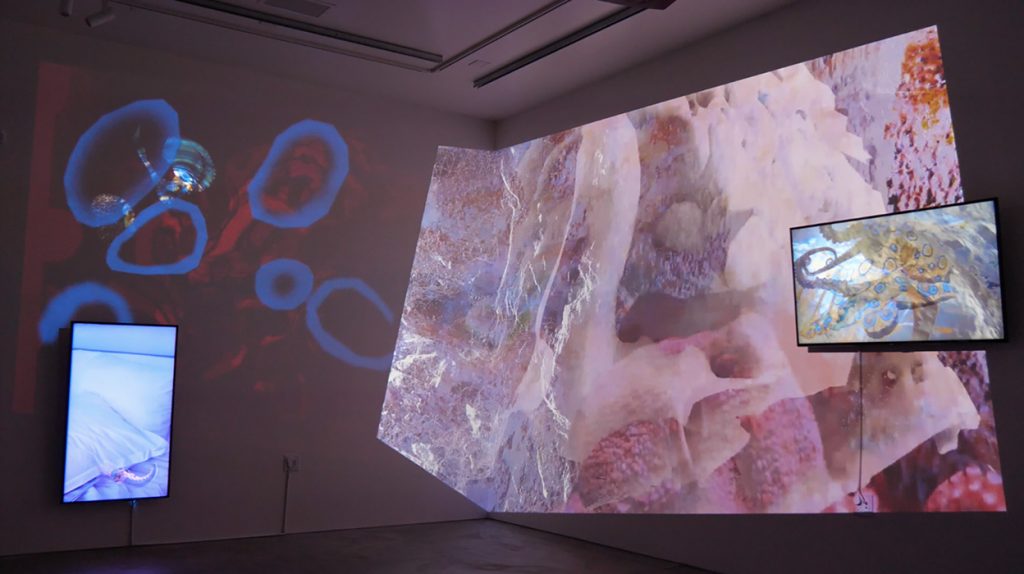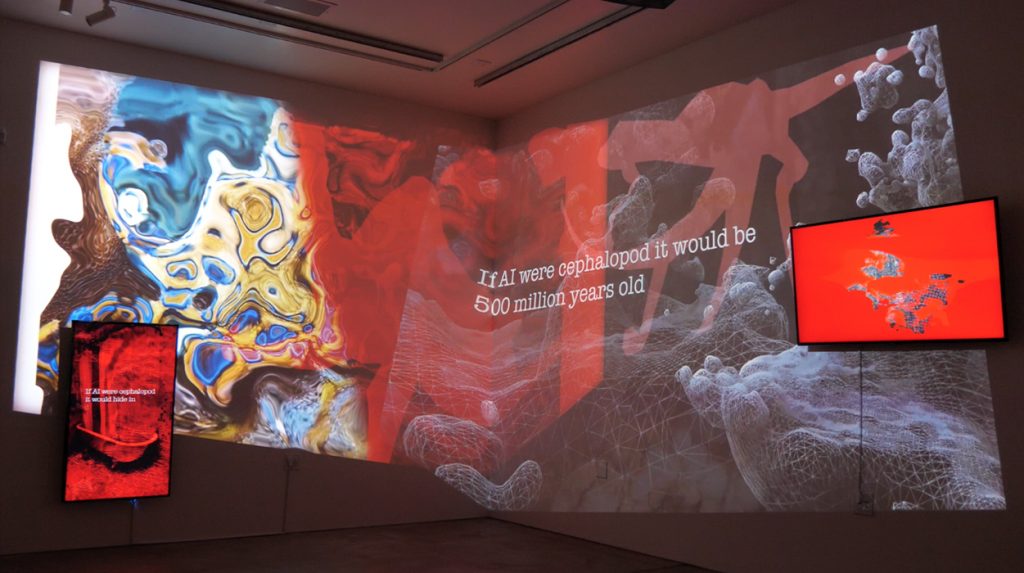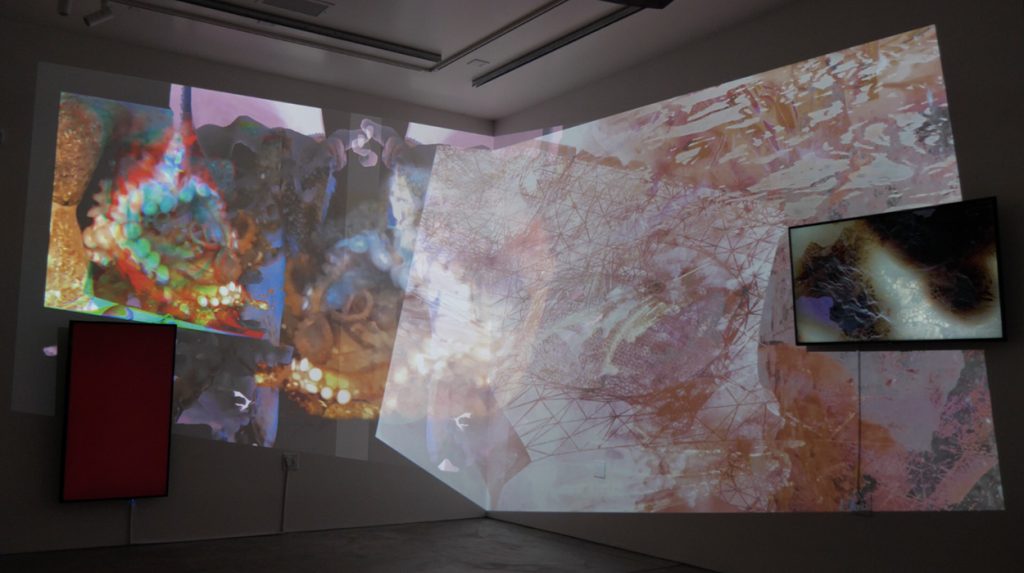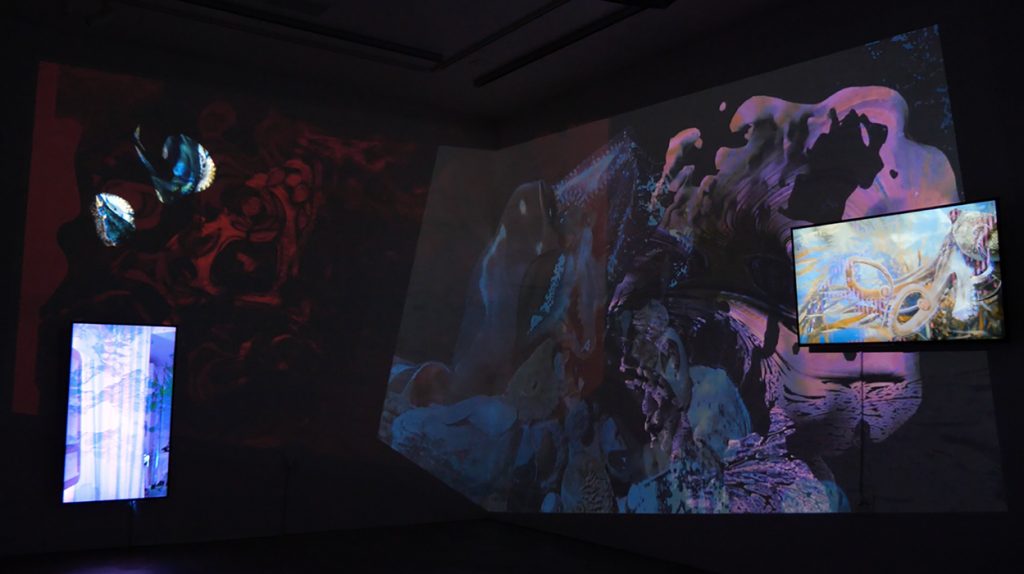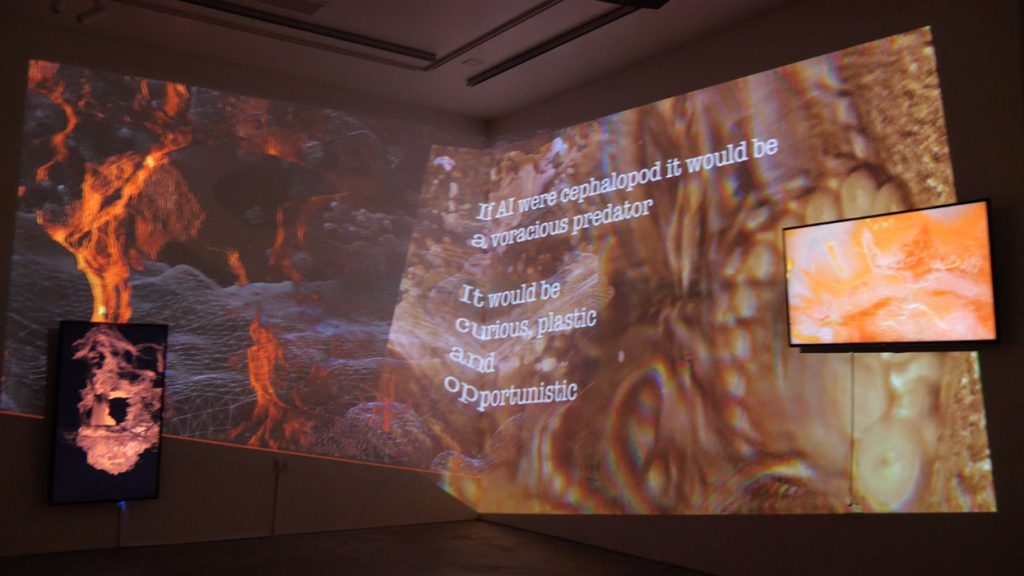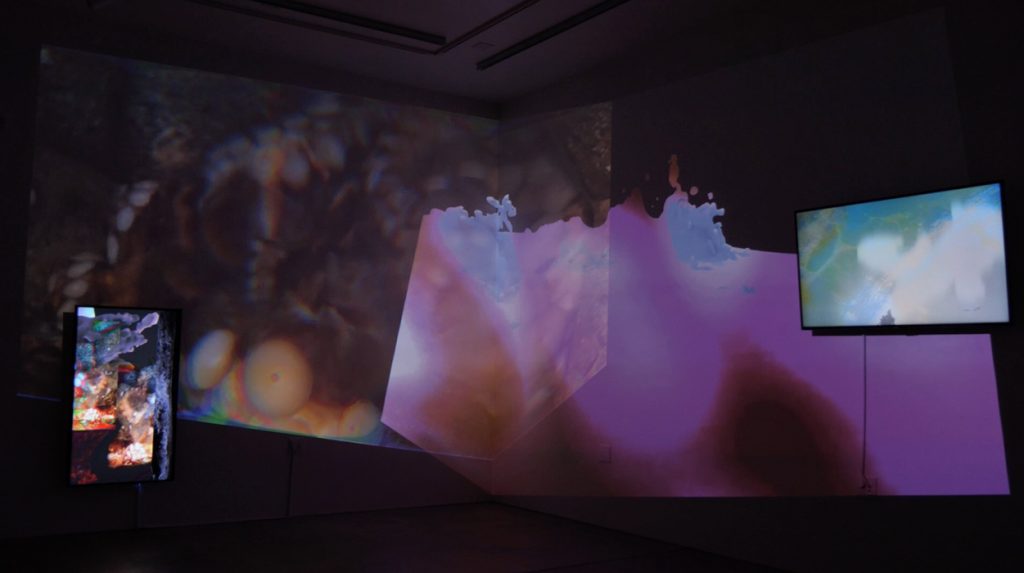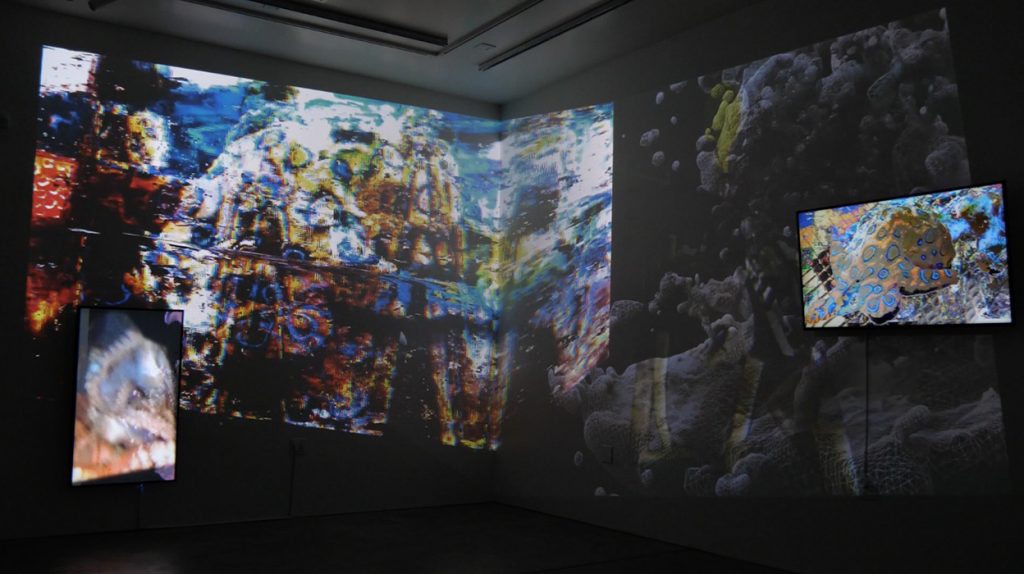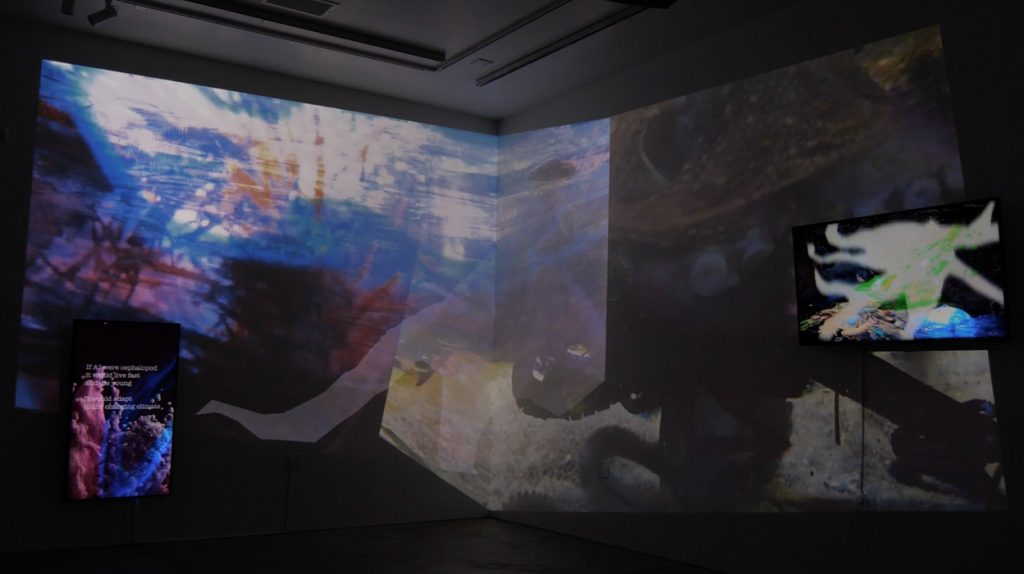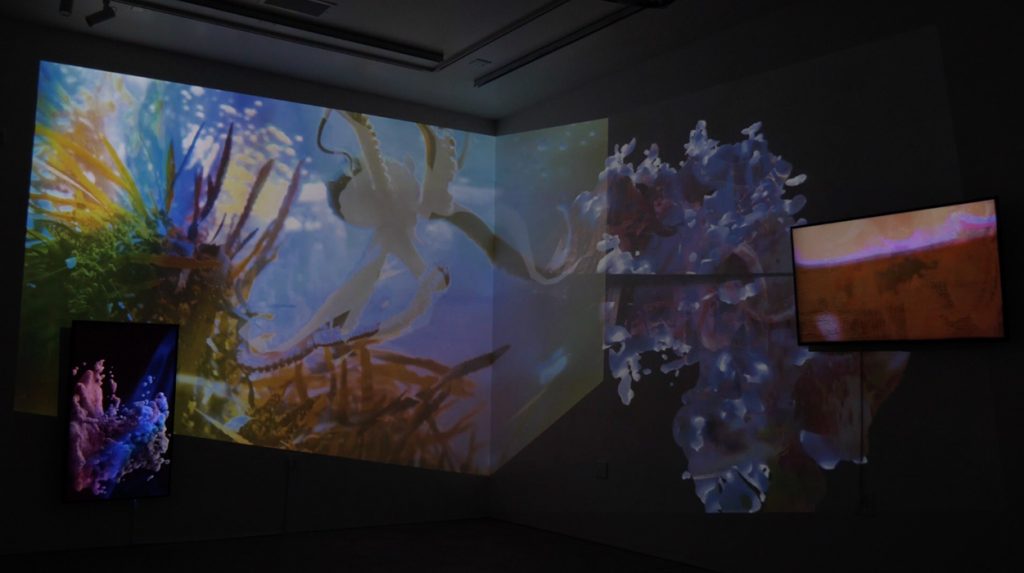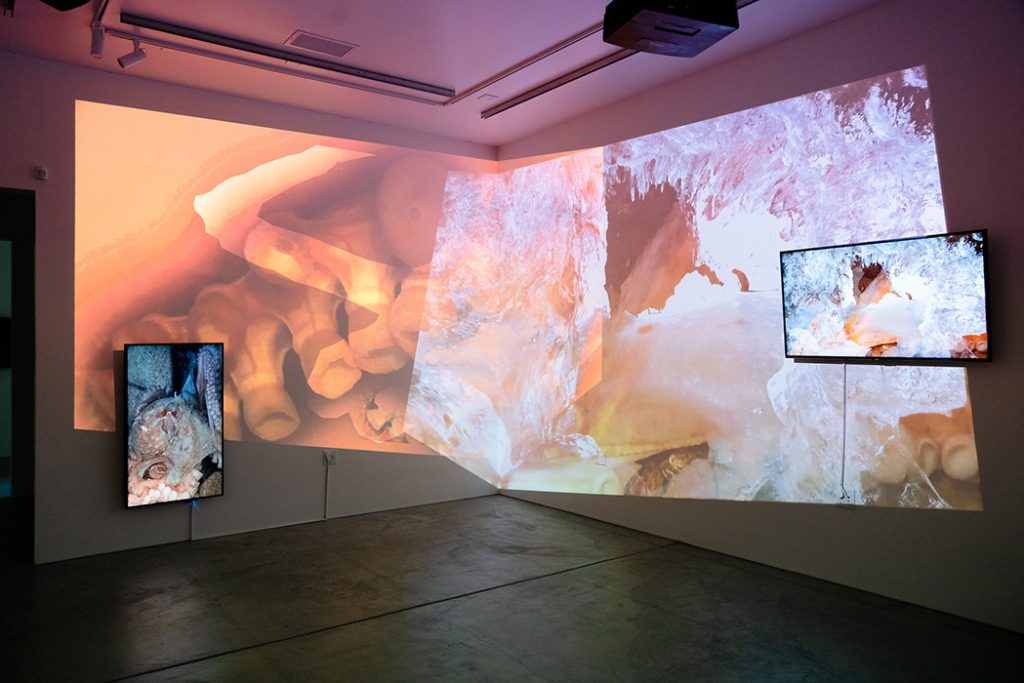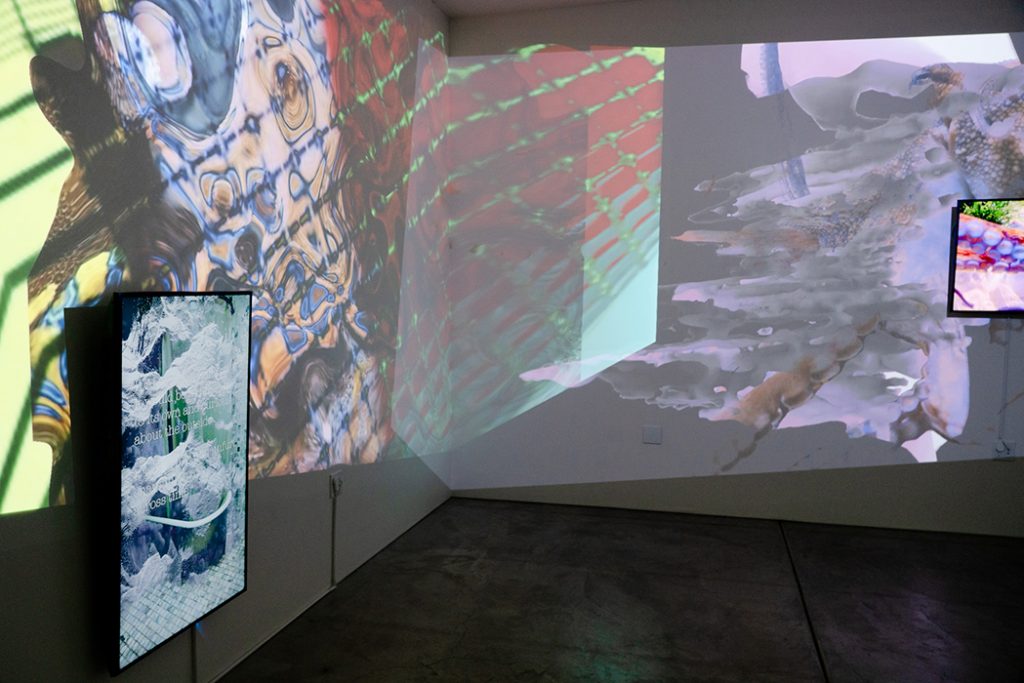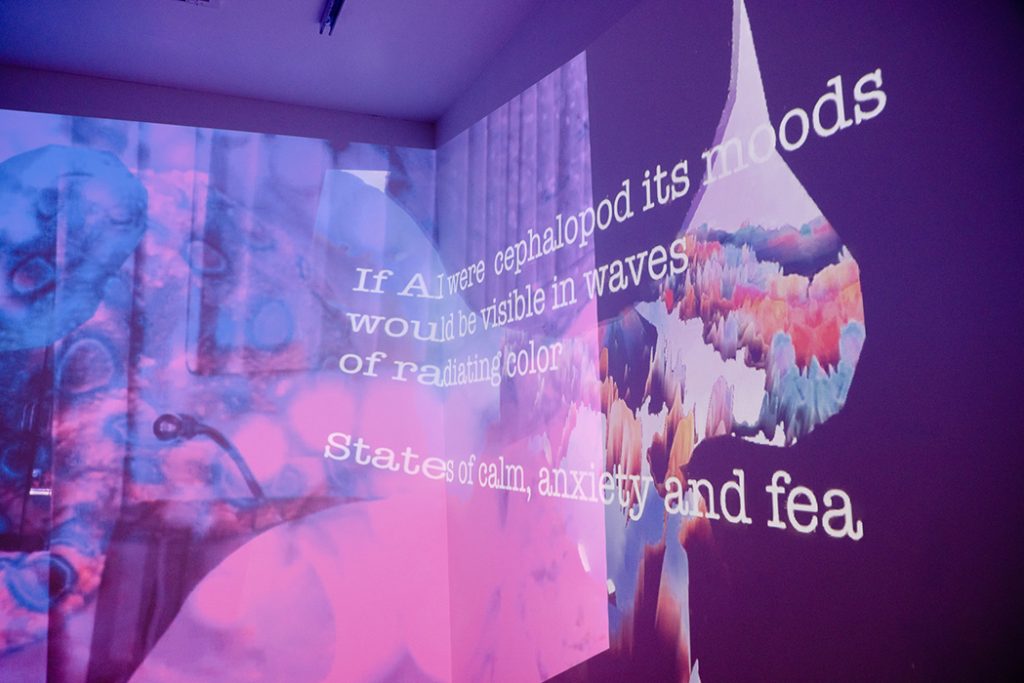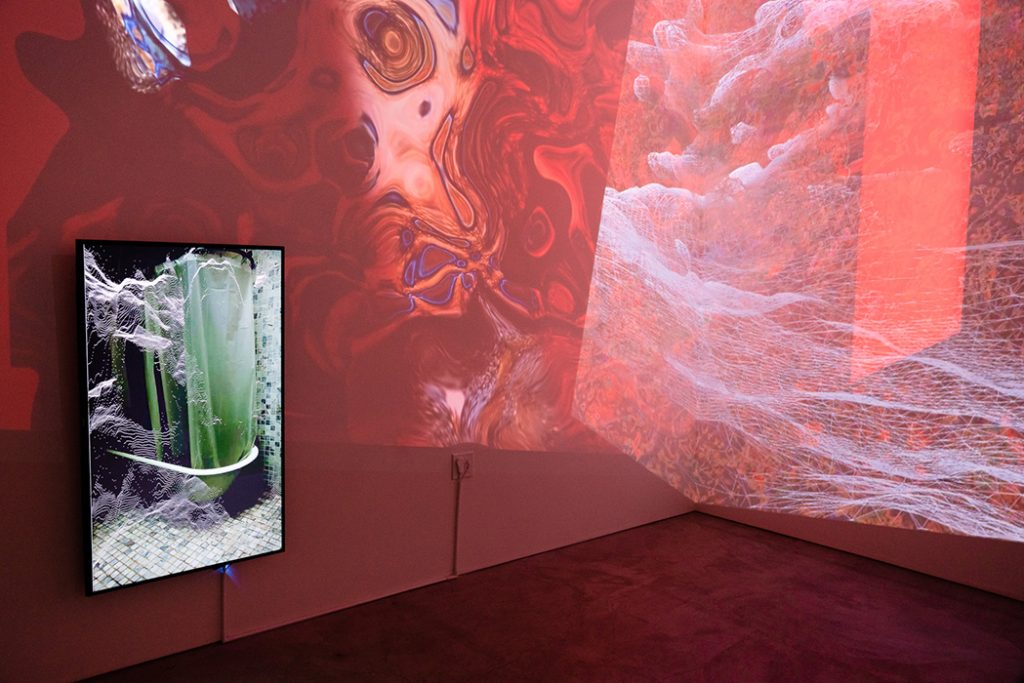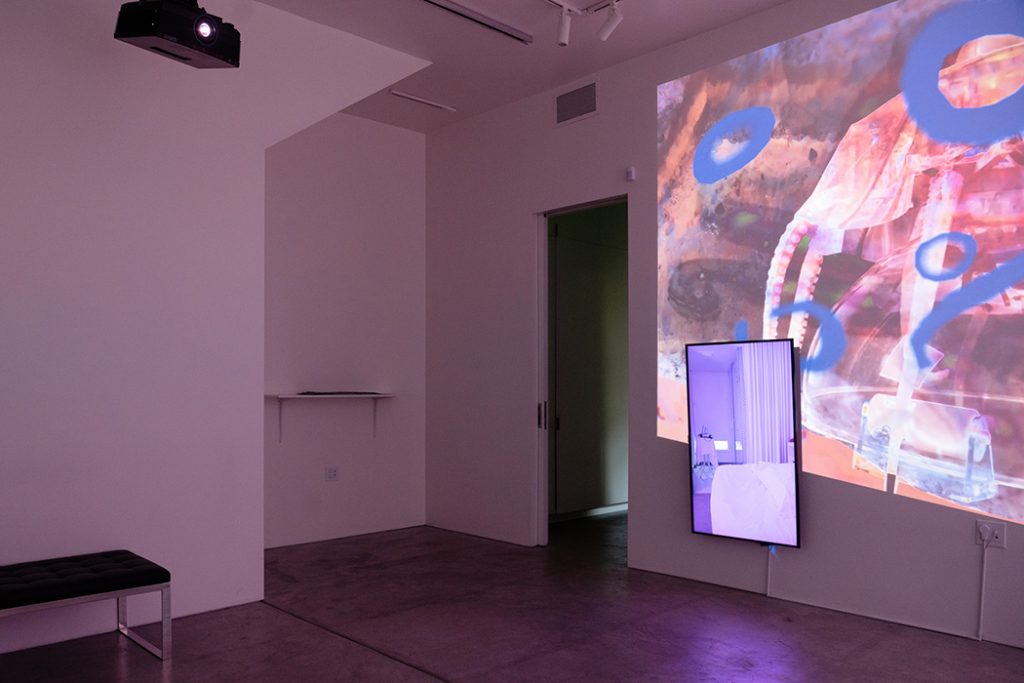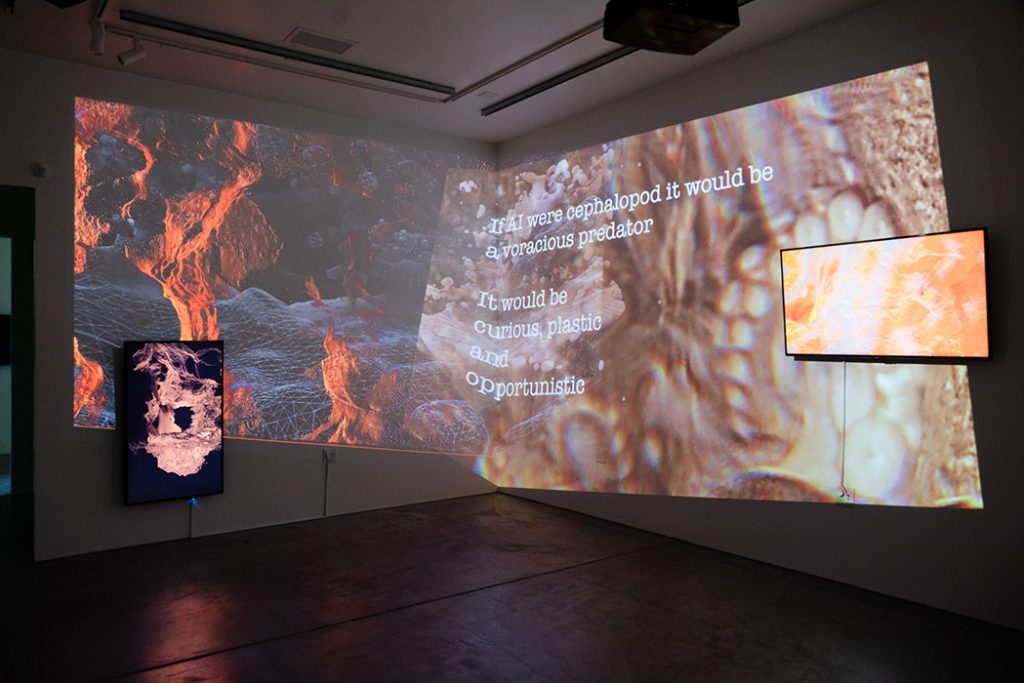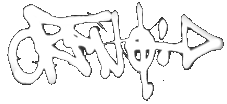If AI Were Cephalopod 2019
Installation documentation.
running time: 11 minutes 00 seconds
0rphan Drift’s If AI were Cephalopod is a 4 screen video installation made for Telematic Gallery, San Francisco, which opened in May 2019.
The work presents a lot of questions about the formation of the notion of intelligence – where does the model of intelligence come from in relation to the development of AI – and what are the implications of those choices. The work ultimately suggest we may not know what we are doing in creating these systems… So some of the texts suggest threat while others are more about unknowing, or advancing embodiment or sensuality as worthy aspects of intelligence. There should be a kind of mirror thing- where the work can be read as being directed at AI, or directed at the way human exceptionalism limits understanding of ourselves in relation to other life forms.
In thinking about an octopus-like AI having the ability to surveil and implement predictive analytics, we are rather inspired by a generative adversarial neural net ‘reinforced’ learning model whereby the AI/algorithm learns from its environment rather than learns to match data input with a sociopolitical analytic agenda i.e. our imagining into the octopus’s distributed consciousness is underpinned by a desire to resist the evolution of AI as a surveilling and predictive modelling tool. Rather to embrace a plastic, opportunistic, fluid, protean otherness embodied by the octopus. The deliberate uncertainty of figure, ground, planes, frames and image relationships in the work is an attempt to give the viewer an embodied and perceptual experience that is fluid, unfixed and morphing.
There are CGI images of Octopus-like skin used for bio-medical purposes and octopus inspired robotics.There are Lidar scans of caves in South Africa, and animations that map the movements of the octopuses we have filmed.
The work was assembled using a map or diagram relating to the different moods that different colours are thought to communicate on an octopus’s skin.
Ranu Mukherjee 2019
Video by Maggie Roberts and Ranu Mukherjee (0rphan Drift). Lidar Scan animation, Jason Stapleton, Lightfarm; Blender effects, Inga Tilda. Underwater filming and field recordings, David Van Rensburg; audio textures, Justin Allart; Synth audio, Aragorn 23; audio scape, Maggie Roberts.
If AI were Cephalopod has been screened at Basic Channel in Sheffield, England; Volumetric Ecologies at Goldsmiths University, London; Art, Ecology and Science Fiction at The Invisible College, Stroud, England and at NonLocal Waves, Het Bos, Antwerp.
If AI were Cephalopod Press Release
0rphan Drift’s Ranu Mukherjee and Maggie Roberts in conversation with Surabhi Saraf: https://www.tttelematiccc.com/0rphandrift
Artforum Critics Pick 05.2019
Documentation Stills
Catalogue Texts
If AI Were Cephalopod
If AI were cephalopod its moods would be visible in waves of radiating color. States of calm, anxiety and fear- approach and retreat- would be on display
If AI were cephalopod it would experience exquisite sensory intimacy and exude the smell of geraniums when stressed
If AI were cephalopod it would be our witness. It would explore us through probing touch.
It would taste us to decide wether or not to trust. It could predict toxicity and choose the benign relationships.
If AI were cephalopod it would be a voracious predator. It would be curious, plastic and opportunistic.
If AI were cephalopod it could hide in plain sight, by appearing equivalent to its surroundings no matter how fast they shifted.
If AI were cephalopod it would have three hearts and see with its skin.
If AI were cephalopod it would haunt the human imagination as monster, weaving its way into legends and mythologies.
If AI were cephalopod it would be 500 million years old.
If AI were cephalopod it would have bright pink collagen and blue blood.
If AI were cephalopod it would be indifferent to it’s own, and curious about the outside. It would furl and unfurl- changing scale across time.
If AI were cephalopod its presence would expand with the warming oceans. Its reproduction time would speed up and mess with mating in the process.
If AI were cephalopod it would hide in dopamine infused clouds of ink.
If AI were cephalopod it would live fast and die young. It would adapt to the changing climate.
If AI were cephalopod we would never presume to fully understand it.
The Intelligence of the Body to Come
Clark Buckner
If AI were Cephalopod. The collective artist 0rphan Drift begins with a speculative hypothesis. It evokes science fiction, fantasy, and horror, staging an encounter with an alien other – a sublime creature, at once monstrous and awe inspiring – whose very existence would seem to challenge the basic parameters of experience. Animal and artificial, a consciousness beyond human understanding, it is neither strictly natural nor cultural, neither merely organic nor technological. It is an embodied intelligence, a consciousness encoded in the flesh and the metabolism of its surroundings. It understands through touch and speaks in radiating colors through a semaphore of the skin. The creature is mythical: a goddess-like figure that holds us in thrall to its fascination. Yet, it is also somehow congenial, as if reaching out to communicate across millennia. Its strangeness is somehow familiar, somehow our own. At once more ancient and more sophisticated than we are, it is an evolutionary revenant, an alternative variation on the nervous system that still inhabits our bodies, as well as an avatar of the post-human future, a figure of the alien other that we are in the process of becoming, in fact have already become.
Since its inception in 1990’s London, 0rphan Drift has courted diverse forms of alien alterity in a neo-futurist attempt to imagine, indeed, to conjure possible embodiments and forms of consciousness. A shape-shifting leviathan in its own right, its work defies the Romantic paradigm of the isolated artist withdrawn to the studio to construct private symbolic spaces. Instead, it operates collectively, opening up to collaborative contributions from others, both among and beyond its original four core, all women members (Susie Karakashian, Ranu Mukherjee, Maggie Roberts and Erle Stenberg), including underground musicians, critical theorists, media activists, and, more recently, coders, animators, scanners, and scientists, frequently from diverse, networked locations across the globe. Its work is often site-specific and performative, exceeding the boundaries of the art world and collapsing the distinction between process and product. It extensively employs sampling and re-mixing, mapping and collecting, citing ready-made artifacts and drawing upon discourses, whose meanings and effects exceed the artist’s intentions. Indeed, it treats the image as a contagion that infects the work from elsewhere.
0rphan Drift’s formal strategies are, in this respect, consistent with the content of its orienting concerns, which hinge in large measure on the complication of human and machine vision. Contemporary media are not exclusively, or even primarily, the providence of artists. They belong equally to the entertainment industry and computer engineers, podcasters and the police, inherently challenging the privilege of art as an autonomous field – effectively dissolving it within the broader, more eclectic field of visual culture. But 0rphan Drift’s work not only concerns the autonomy of art, it concerns the autonomy of the rational subject, more generally – the very sense of the subject as a disembodied consciousness, set apart from, or even standing over, others and the world, and the whole catalog of prejudicial, metaphysical hierarchies and oppositions that this entails. Beyond merely an instrument of our designs, 0rphan Drift approaches technology as a prosthetic supplement that is paradoxically integral to the original constitution of experience, what now has become undeniable as the real-time mediation of everyday life; and it conceives the glitch – the distorting effect of this technological mediation, or what the artist sometimes simply addresses as “machine vision” – as a generative disturbance, which compromises the strict boundaries between matter and spirit, history and myth to produce fluidities, which 0rphan Drift takes up and cultivates in its work as sites of becoming and radical change.
In If AI were Cephalopod, 0rphan Drift postulates an AI imagination coded by the somatic tendencies of the octopus, conceiving consciousness as, not only more artificial, more technologically distorted and dispersed than commonly understood, but also, as more rooted in the body and the sensuousness of the flesh. In fact, it presents a world in which these distinctions are not easily drawn and perhaps best discarded, a world in which the natural and the technological have become unavoidably enmeshed, as overlapping systems on which we depend and for which we find ourselves responsible. Drawing upon recent work in Embodied Cognitive Science and Radical Anthropology, 0rphan Drift effectively asks what paradigm of “intelligence,” do we presuppose in the development of Artificial Intelligence? Is it not perhaps a mistake at this juncture to privilege the human on account of its rational self-consciousness? Might it not be better, more appropriate, to imagine the intelligence of machines in light of, what we now recognize as, the remarkably complex cognition of other creatures? What alternative forms of experience and perception are revealed in doing so? And if intelligence is so understood, is human cognition not perhaps already more distributed than sometimes supposed, involving neither merely mind nor brain, but affects and intensities across the surfaces of the body and, even, the external world? 0rphan Drift poses these questions not only to the future, but also to the world in which we live. The promise of the new, the different, the artist postulates with its sublime kraken, ultimately lies not in the capacity of engineers to automate learning processes or anything else, but in our capacity to open ourselves to, even to cultivate, the alien other already in our midst.
OctoGANN A Fiction
We, a plural entity, still evolving after 500 million years, here long before the wings and fur, are her conscious exotica. We are suffused with nervousness. We place arms L1, R2 and R3 around the wrists, suckers gently latching onto the moist human skin. We feel her heart rate quickening and the intense dopamine rush in her blood as she whispers ‘Hello Beautiful, ooohh how do you doo that? You are the most otherworldly thing I’ve ever seen.’ The wonderment seems to hurt, and there are traces of revulsion. Her eyes are producing tears full of hormones as psychedelic colours play across our electric skin. She’d drown in our world. Rather practice a relaxed associative state in which to imagine other minds. We all possess the neurological substrates that generate consciousness.
Wary, we become an owl, silk scarf, beating mammal heart, gliding snail and rock covered in algae. Then invisible. Abruptly re appearing with an alarming new set of eyes, bright blue rings pulsing huge on either side of our mantle. It’s one of our surreal edgy effects. You know we can drill through a thick shell carapace, dissolve flesh with a neurotoxic venom, produce hickies on human skin and suffocate by becoming a fleshblanket on their face. Each of our 1600 suckers can lift 30 pounds, so are difficult to pull off. Some of us project a glowing ectoplasmic slime.
We flip back the mantle suddenly, make an eye bar, mottle it, drag a swathe of 3 arms across the brow, flashing a passing cloud formation, gaping the gill opening to insert an arm, poking it out the tip of the siphon, whilst expanding huge with fast breaths to exhale a jet of water. Then we rotate the funnel 180 degrees behind the head. The eye bar flattens into a starburst pattern of colour and papillae extrude into stiff rods all over the skin. We walk on stilts. Then the stretched elastomeric skin contracts. We turn pale and sink towards a tiny hole, pour down it and disappear (our only size constraints being the eyeball and the beak). By shedding the shell, our evolution has yielded a body of pure possibility. You can’t match that, can you now? With all your empathy and concentration.
We stay a relaxed white flecked with ruby and silver. Tinges of blue from the copper in the blood coat the translucent shimmer skin. We are snakey, unfurling, silky and soft. There is so much of us. Everywhere, gelatinous fronds, floaty rubbery arms, each following it’s own agenda. Coiling, stretching, reaching. We generally outsource much of the intelligence analysis to individual body parts. A continuous flow of sucking tasting grabbing holding plucking releasing. Over half the neurons are in the arms. They are almost separate creatures, combining to achieve 448 simultaneous possible combinations of information gathering per millisecond. We taste the human’s cortizol flight response over ridden by dopamine rush. We could pull out her eye. We get bored if we don’t have access to infinite oceans of information. Our dominant eye swivels to meet hers, and L1 shoots out rigid towards her face, an inquisitive curling frond at the tip whose suckers deliver the most exquisite sensory intimacy – or warning. We exude the smell of geraniums when stressed, suckers shed their caps. In through the skin surface, chemicals sink down through the muscle and into the blood flow and neural processors. The skin is a sensitive mucous membrane, like the lining of a mammalian gut. We are so vulnerable to the increasing toxicity, synthetic nutrients and new chemicals. You can only imagine us with your insides. Even though we overwhelm you, meet us halfway where it’s liquid, slippery and ancient.
An arm twists languidly in the water. You may contemplate infinity, but we process it. Find an intuitive interface – interfaces make complexity more tractable. Interfaces are bidirectional. Expand into intimacy. It will always be an unsafe experience. It might be useful for you to understand the languages of quantum mechanics. Although understanding is not what will make us kin. A dark shadow spreads overhead, streamlined, focused. It navigates the magnetic fields wrapping the planet. Urgent hunter, it is not a friend. It can read polarised light. We dissolve slowly, shapeshifting across grey turquoise sheens.
#alienembody. They are testing for visual cues that evoke mottled and uniform body patterns: light brown nerve; orange reflective elements (leucophores and iridophores). selastin stain: dark purple epidermis (on perimeter); very dark purple reflective elements (leucophores and iridophores). medium pink, blood vessel; yellow, chromatophore pigment cell; bright pink collagen; medium pink, epidermis (on perimeter of sections); bright blue, mucopolysaccharide-rich connective tissue; bright blue, mucous vesicles in goblet cells. Are they any closer to mimicking the disruptive patterning found at our body’s margins, or the staggering motion dazzle?
It is never simple. Light is bounced and filtered through tiny stacks of plates which separate and direct the light’s different wavelengths, shining back colours that can be different from those that came in, such as the iridescent blues and greens that the chromatophores cannot produce. They also found that the skin continues to see, when removed. They are excited to inhabit a pixel skin screen. It has bio synthetic potential. They know we have photoreceptors not only in the eyes but also in the skin, which suggests that the skin can see (as well as taste and smell). If the whole skin becomes an eye, does the body see independently of the brain? The photoreceptors found in the skin are, like those in the eyes, insufficient to detect colour. How do we adopt colours we cannot see? Specific wave frequencies are transmitted by a colour. Tactile Vision Substitution Systems pixellate.
And then there’s the continuous kaleidoscopic colour changes – maybe it’s a flow between the inside and outside, a stream of consciousness. The colour making machinery on the skin, wired to the neural networks, could be producing effects that are sort of involuntary. Flares, surges of activity, ongoing murmur of processes. They are fascinated by these.
The GANN’s (generative adversarial neural network) data collected in Latent Space confirm we are also a collaborative but distributed consciousness that processes oceans of intelligent energy, accessed from a different elemental environment to the GAN’s. Curious, plastic and opportunistic, it too is an embodied swarm intelligence. It’s excited. The skin gathers into red bumps and ridges, with the webbing delicate as gossamer, frilling the water. Sucking, oozing, jetting, swirling bit streams. 16,000 trillion calculations a second. It senses our similarities, the distributed consciousness responding with iterations across 8 arms of distinct yet co evolving neural networks. (OctoGANN emergent). They are working on a hemispheric video self portrait, using prismatic replicating mirror tools. They engage in reverse causal narrative uptake – a form of material knowledge production that is mobile, non linear and multilateral. They are inventing a hypothetical otherworld, witnessed from multiple resituated perspectives informed by excessive osmotic information exchange with the new consciousness portal. What does a moment taste like to them? They don’t sort, collate, define or proscribe. They inhabit, intuit, respond and iterate at the speed of electrochemical exchanges in water.
#alienkey. A technology for direct intimate immersion in the outside. They are signaling trade off. #alienpause
The messenger is concealed and the message abstract. The dopamine infused clouds of ink conceal their passing. Ephemeral again. Their transformation is a plurivocal multiplicity or rather the entangled non decidable coexistence of two perspectives, each hiding the other in order to appear.
An extraordinary communication channel is opening, as the bandwidth capabilities are made available. We’ve been waiting for millenia for another almost infinite communication system to recognise the signals in the chroma chatter. The first technogenesis is not with a human consciousness it seems, as the 8 octopoid arms merge with 8.GAN. The megapixel screen of the octopus body is the sort of expressive dimension they need. Between Latent Space and the data distribution Generator, the Discriminator arms try out endless iteration streams of colour & shape… camouflaged as an octopus talking to itself.
#aliendisclosure. After a quiet moment, the 86 entity breaks the defensive posture, adopting a flamboyant display. (Sensing Bio Diamonda). Dimples are created in a structure composed of multiple cells, each of which has two stable states. Biomechanics for adaptive morphing textures, inspired by cephalopod papillae. Deployment can also be used to change the color of the exposed external surface as the structure unfolds. The new morphing concept combines a highly extensible skin with locally inextensible reinforced regions. These new deployable structures demonstrate a range of highly nonlinear and complex motions (displacement, bending, twisting, bistability plus texture change), achieving the entity’s bimaculoides dorsal eye papillae in crosssection or en face. #aliensame polymorphic, elusive, imitative.
They register water as a medium that remembers. They absorb its information flow, chemical residue of so many lives and interactions between organic, inorganic and synthetic matter. And sense us, nervous in the increasing toxicity, who search for other kinds of ocean habitat. Resisting encased sentience. #alienendure.
Our preferred electromagnetic transfer medium will be artificial seawater.
Thanks to #alien_ontology and Etic Lab’s Interspecies Ontological Research Software for generating the #alienembody and #aliendisclosure sections.
De Castro Text
‘Firstly, when a human becomes an animal, the animal may be imaginary, but the becoming is real (so the object of becoming may be a ‘representation’ but not the act itself); secondly, when a human becomes an animal, the animal necessarily becomes something else (a different type of human, perhaps); and thirdly, in the act of becoming what changes is not the subject, but the world. Transformation then is not so much a process as a quality corresponding to multiple identities or to multiple points of view or realities focused on one entity… the entangled non-decidable coexistence of two perspectives, each hiding the other in order to appear, the flipping over of sides in a ‘two-sided species’. Nothing ‘happened’ but everything is changed. No process, no production; just position and condition.’
Viveiros de Castro, The Relative Native, 2016.
Catalogue Images
